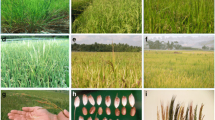Abstract
There is a remarkably high level of variation within cultivated sesame and sorghum in the Nuba Mountains of Sudan although the region is relatively small. The Nuba people are geographically isolated and culturally diverse in religion, language, material inventory, agricultural practices and in their rituals involving crop plants, and this contributes to the diversity in their cultivars. Nuba crop husbandry is sophisticated and high levels of genetic diversity are maintained by deliberate selection of crop varieties that are well adapted to each of the microenvironments of the region and best suited for different economic uses.
Similar content being viewed by others
Literature Cited
Andrews, F. W. 1956. The Flowering Plants of the Sudan. V. 3. Printed for the Sudan Gov. by T. Buncle, Arbroath, Scotland.
Barbour, K.M. 1961. The Republic of the Sudan, a Regional Geography. Univ. London Press, London.
Bell, G.W. 1938. Nuba agricultural methods and beliefs. Sudan Notes & Records 21: 237–249.
Crawford, O.G.S. 1951. Fung Kingdom of Sennar. John Bellows, Gloucester, England.
Greenberg, J. 1955.Studies in African Linguistic Classification.Compass, New Haven, CT.
—. 1966. Languages of Africa. Indiana Univ., Bloomington, IN; Mouton, The Hague, Netherlands.
el, Hadari, A.M. 1974. Some socio-economic aspects of farming in the Nuba Mountains, Western Sudan. Eastern Africa J. Rural Developm. (Kampala) 7: 157–176.
Harlan, J.R. 1951. Anatomy of gene centers. Amer. Naturalist 85: 97–103.
Holt, P.M. 1961. A Modern History of the Sudan. Weidenfeld & Nicholson, London.
MacMichael, H.A. 1967. Tribes of Northern and Central Kordofan. Frank Cass, London.
March, G.F. 1936. Development of native agriculture in the Nuba Mountains area of Kordofan Province, Anglo-Egyptian Sudan. Empire J. Exp. Agric. 4: 77–80.
-March, G.F.. 1944. Note on the Nuba Mountains area of Kordofan.In Report of the Soil Conservation Committee. Appendix 20, p. 133–135. Sudan Gov. Khartoum, Sudan.
—. 1948. Kordofan Province.In Agriculture in the Sudan, J. D. Tothil, ed, p. 827–850.Oxford Univ. Press, London.
Nadel, S.F. 1947. The Nuba. Oxford Univ. Press, London.
Sagar, J.W. 1922. Notes on the history, religion and customs of the Nuba. Sudan Notes & Records 5: 139–144.
Seligman, C.G., and Seligman, B.Z. 1932. Pagan Tribes of the Nilotic Sudan. Reissue 1965, Routledge & Kegan Paul, London.
Sudan. 1912. Kordofan and the Region to the West of the White Nile. Anglo-Egyptian Handbook Series. Compiled by Intelligence Dept. Sudan Government, Khartoum. Printed for His Majesty’s Stationery Office, Harrison & Sons, London.
Weiss, E.A. 1971. Castor, Sesame and Safflower. Barnes & Noble, New York.
Wernstedt, F.L. 1972. World Climatic Data. Climatic Data Press, Lemont, PA.
Wood, R. G. 1971. Agricultural Systems in the Nuba Mountains, Sudan. Ph.D. diss., Univ. California, Los Angeles.
Yassin, T.E. 1978. Phenotypic variation in local sorghums in the Sudan Nuba Mountains. Exp. Agric. 14: 181–188.
Author information
Authors and Affiliations
Additional information
Much of this report is based on field research carried out (by DB) in the Nuba Mountains between mid-October and mid-December 1979. The Sudanese government limits access to the area but special permission was received to travel there.
Most vernacular names in the text are in the Arabic language and are commonly used by Nuba and Arab alike.
Rights and permissions
About this article
Cite this article
Bedigian, D., Harlan, J.R. Nuba agriculture and ethnobotany, with particular reference to sesame and sorghum. Econ Bot 37, 384–395 (1983). https://doi.org/10.1007/BF02904199
Received:
Accepted:
Issue Date:
DOI: https://doi.org/10.1007/BF02904199




